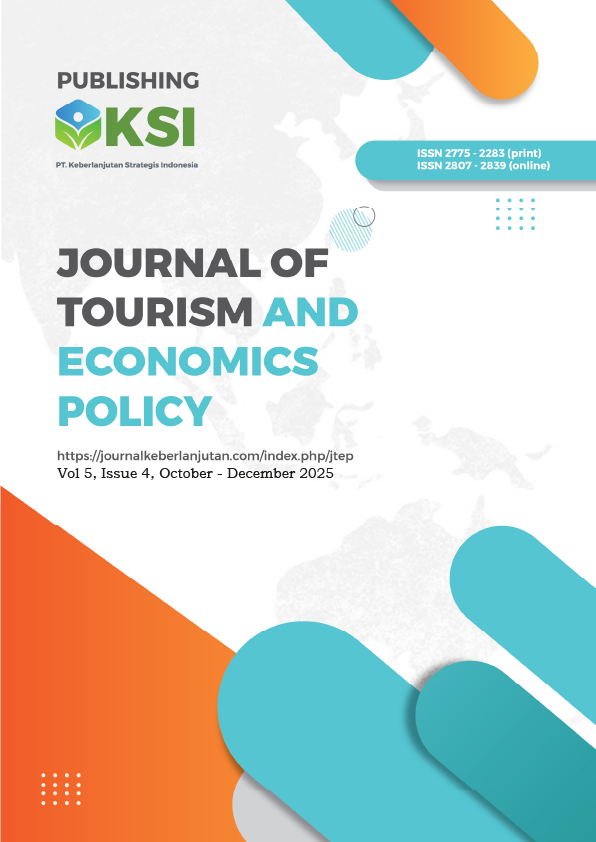Building a Sport Tourism Hub in the Heart of Central Java: A Comprehensive Analysis of Surya Yudha Park Banjarnegara Development
DOI:
https://doi.org/10.38142/jtep.v5i4.1390Keywords:
Sport Tourism, Sport Tourism Hub, Surya Yudha Park, Banjarnegara, Quality InvolvementAbstract
This study analyzes the potential for developing Surya Yudha Park Banjarnegara as a leading sports tourism destination in Central Java. This qualitative research was conducted for three months (January-March 2025) using in-depth interview methods, participatory observation, and documentation studies of 11 key informants. The results of the study indicate that Surya Yudha Park has enormous strategic potential to develop into a sports tourism hub thanks to its strategic geographical position as the "heart of Central Java", complete sports facilities (international standard futsal field, sports swimming pool, fitness center, and indoor tennis court), and government policy support through the "10 New Bali" program. However, there are significant challenges in the form of limited expertise in sports facility management, HR competency gaps, an unintegrated management system, limited accessibility, and competition with metropolitan destinations. Recommended quality improvement strategies include: adoption of a three-phase development approach, organizational restructuring with the formation of a Sport Tourism Division, integration of a smart facility management system, formation of a Sport Tourism consortium, and revenue diversification. The implementation of this strategy is expected to position Surya Yudha Park as a leading sports tourism destination that contributes to local economic development and sustainable tourism.
References
Adventure Travel Trade Association. (2023). Adventure Travel Research. Adventure Travel Trade Association. https://learn.adventuretravel.biz/research
Akhtar, N., Khan, N., Mahroof Khan, M., Ashraf, S., Hashmi, M. S., Khan, M. M., & Hishan, S. S. (2021). Post-covid 19 tourism: Will digital tourism replace mass tourism? Sustainability (Switzerland), 13(10). https://doi.org/10.3390/su13105352
Braun, V., & Clarke, V. (2006). Using thematic analysis in psychology. Qualitative Research in Psychology, 3(2), 77–101. https://doi.org/10.1191/1478088706qp063oa
Cao, A., Shi, F., & Bai, B. (2022). A comparative review of hospitality and tourism innovation research in academic and trade journals. International Journal of Contemporary Hospitality Management, 34(10), 3790–3813. https://doi.org/10.1108/IJCHM-11-2021-1443
Creswell, J. W., & Poth, C. N. (2016). Qualitative inquiry and research design: Choosing among five approaches (4th ed.). Sage publications.
Downward, P., Hallmann, K., & Pawlowski, T. (2014). Assessing parental impact on the sports participation of children: A socio-economic analysis of the UK. European Journal of Sport Science, 14(1), 84–90. https://doi.org/10.1080/17461391.2013.805250
Getu, Z., & Amelia, A. (2023). Strategic Planning Through Sport Events Leveraging Essentially. Journal Research of Social Science, Economics, and Management, 2(10), 2528–2549. https://doi.org/10.59141/jrssem.v2i10.488
Gibson, H. (2017). Sport tourism and theory and other developments: some reflections. Journal of Sport and Tourism, 21(2), 153–158. https://doi.org/10.1080/14775085.2017.1319514
Gibson, H. J. (1998). Sport Tourism: A Critical Analysis of Research. Sport Management Review, 1(1), 45–76. https://doi.org/10.1016/S1441-3523(98)70099-3
Hinch, T. D., & Higham, J. E. S. (2001). Sport tourism: a framework for research. International Journal of Tourism Research, 3(1), 45–58. https://doi.org/10.1002/1522-1970(200101/02)3:1<45::aid-jtr243>3.0.co;2-a
Kementerian Pariwisata dan Ekonomi Kreatif. (2023). Outlook Pariwisata dan Ekonomi Kreatif.
Martins, R., Mascarenhas, M., & Pereira, E. (2024). Exploring strategic multi-leveraging of sport tourism events: An action-research study. Journal of Destination Marketing and Management, 32(November 2023), 100902. https://doi.org/10.1016/j.jdmm.2024.100902
Mustafa, M. J., Lee, C., & Galloway, J. E. (2023). The importance of context: How university entrepreneurial climates enhances entrepreneurship in tourism and hospitality graduates. Journal of Hospitality, Leisure, Sport and Tourism Education, 33(January), 100453. https://doi.org/10.1016/j.jhlste.2023.100453
Njoroge, M., Anderson, W., & Mbura, O. (2019). Innovation strategy and economic sustainability in the hospitality industry. Bottom Line, 32(4), 253–268. https://doi.org/10.1108/BL-03-2019-0080
UN Tourism. (2023). UN Tourism Recovery Tracker. UN Tourism. https://www.unwto.org/unwto-tourism-recovery-tracker
Waruwu, A., Tinggi, S., Ekonomi, I., & Indonesia, P. (2024). Improving the resilience of sorake beach destination : an integrated education and training program to balance the impact of foreign tourist visits. 14(10).
Weed, M. (2005). Sports Tourism Theory and Method—Concepts, Issues and Epistemologies. European Sport Management Quarterly, 5(3), 229–242. https://doi.org/10.1080/16184740500190587
Wilco, C., Leon, L., Chammy, L., & Derek, P. (2024). Rest station’s value-added amenities for biking tourism and leisure: Perspectives of seasoned bicyclists and infrequent bicyclists. Transport Policy, 149(January), 1–10. https://doi.org/10.1016/j.tranpol.2024.01.025
Downloads
Published
Issue
Section
License
Copyright (c) 2025 Ari SUBARA, Pranoto PRANOTO

This work is licensed under a Creative Commons Attribution-NonCommercial 4.0 International License.
Creative Commons Attribution-NonCommercial 4.0 International License.





















